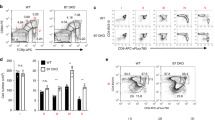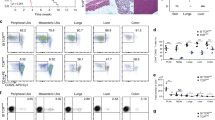Abstract
CD1d-restricted invariant natural killer T cell (iNKT cells) have a limited T cell receptor (TCR) repertoire and share characteristics common to T cells and natural killer cells. While intrathymic selection facilitates the production of T cells carrying self major histocompatibility complex–restricted TCRs, natural killer cells carry an appropriate repertoire of self major histocompatibility complex–recognizing receptors to avoid self-reactivity. Here we show that chronic exposure to specific glycolipid antigen resulted in iNKT cell disappearance and thymus-dependent repopulation of iNKT cells with increased expression of inhibitory Ly-49 molecules that resulted in impaired responsiveness. Thymic selection of peripheral Ly-49-expressing iNKT cell repertoire inhibited cytokine production and other functions in vivo. These observations emphasize the acquisition of self-recognizing inhibitory receptors on NKT cells as a previously unknown mechanism of thymic tolerance after chronic antigen exposure.
This is a preview of subscription content, access via your institution
Access options
Subscribe to this journal
Receive 12 print issues and online access
$209.00 per year
only $17.42 per issue
Buy this article
- Purchase on Springer Link
- Instant access to full article PDF
Prices may be subject to local taxes which are calculated during checkout








Similar content being viewed by others
References
Bendelac, A. et al. CD1 recognition by mouse NK1+ T lymphocytes. Science 268, 863–865 (1995).
Bendelac, A., Rivera, M.N., Park, S.H. & Roark, J.H. Mouse CD1-specific NK1 T cells: development, specificity, and function. Annu. Rev. Immunol. 15, 535–562 (1997).
Godfrey, D.I., Hammond, K.J., Poulton, L.D., Smyth, M.J. & Baxter, A.G. NKT cells: facts, functions and fallacies. Immunol. Today 21, 573–583 (2000).
Kronenberg, M. & Gapin, L. The unconventional lifestyle of NKT cells. Nat. Rev. Immunol. 2, 557–568 (2002).
Yokoyama, W.M. & Plougastel, B.F. Immune functions encoded by the natural killer gene complex. Nat. Rev. Immunol. 3, 304–316 (2003).
Smyth, M.J. et al. NKT cells—conductors of tumor immunity? Curr. Opin. Immunol. 14, 165–171 (2002).
Yang, J.Q. et al. Repeated α-galactosylceramide administration results in expansion of NK T cells and alleviates inflammatory dermatitis in MRL-lpr/lpr mice. J. Immunol. 171, 4439–4446 (2003).
Starr, T.K., Jameson, S.C. & Hogquist, K.A. Positive and negative selection of T cells. Annu. Rev. Immunol. 21, 139–176 (2003).
Davis, M.M. & Bjorkman, P.J. T-cell antigen receptor genes and T-cell recognition. Nature 334, 395–402 (1988).
Garcia, K.C., Teyton, L. & Wilson, I.A. Structural basis of T cell recognition. Annu. Rev. Immunol. 17, 369–397 (1999).
Sebzda, E. et al. Selection of the T cell repertoire. Annu. Rev. Immunol. 17, 829–874 (1999).
MacDonald, H.R. Immunology. T before NK. Science 296, 481–482 (2002).
Gapin, L., Matsuda, J.L., Surh, C.D. & Kronenberg, M. NKT cells derive from double-positive thymocytes that are positively selected by CD1d. Nat. Immunol. 2, 971–978 (2001).
Chun, T. et al. CD1d-expressing dendritic cells but not thymic epithelial cells can mediate negative selection of NKT cells. J. Exp. Med. 197, 907–918 (2003).
Benlagha, K., Kyin, T., Beavis, A., Teyton, L. & Bendelac, A. A thymic precursor to the NK T cell lineage. Science 296, 553–555 (2002).
Pellicci, D.G. et al. A natural killer T (NKT) cell developmental pathway involving a thymus-dependent NK1.1−CD4+ CD1d-dependent precursor stage. J. Exp. Med. 195, 835–844 (2002).
Kawano, T. et al. CD1d-restricted and TCR-mediated activation of Vα14 NKT cells by glycosylceramides. Science 278, 1626–1629 (1997).
Sidobre, S. et al. The Vα14 NKT cell TCR exhibits high-affinity binding to a glycolipid/CD1d complex. J. Immunol. 169, 1340–1348 (2002).
Eberl, G. & MacDonald, H.R. Rapid death and regeneration of NKT cells in anti-CD3ε- or IL-12-treated mice: a major role for bone marrow in NKT cell homeostasis. Immunity 9, 345–353 (1998).
Eberl, G. & MacDonald, H.R. Selective induction of NK cell proliferation and cytotoxicity by activated NKT cells. Eur. J. Immunol. 30, 985–992 (2000).
Crowe, N.Y. et al. Glycolipid antigen drives rapid expansion and sustained cytokine production by NK T cells. J. Immunol. 171, 4020–4027 (2003).
Wilson, M.T. et al. The response of natural killer T cells to glycolipid antigens is characterized by surface receptor down-modulation and expansion. Proc. Natl. Acad. Sci. USA 100, 10913–10918 (2003).
Singh, N. et al. Cutting edge: activation of NK T cells by CD1d and α-galactosylceramide directs conventional T cells to the acquisition of a Th2 phenotype. J. Immunol. 163, 2373–2377 (1999).
Burdin, N., Brossay, L. & Kronenberg, M. Immunization with α-galactosylceramide polarizes CD1-reactive NK T cells towards Th2 cytokine synthesis. Eur. J. Immunol. 29, 2014–2025 (1999).
Fujii, S., Shimizu, K., Kronenberg, M. & Steinman, R.M. Prolonged IFN-γ-producing NKT response induced with α-galactosylceramide-loaded DCs. Nat. Immunol. 3, 867–874 (2002).
Pellicci, D.G. et al. Intrathymic NKT cell development is blocked by the presence of α-galactosylceramide. Eur. J. Immunol. 33, 1816–1823 (2003).
Robson MacDonald, H., Lees, R.K. & Held, W. Developmentally regulated extinction of Ly-49 receptor expression permits maturation and selection of NK1.1+ T cells. J. Exp. Med. 187, 2109–2114 (1998).
Voyle, R.B. et al. Ligand-dependent inhibition of CD1d-restricted NKT cell development in mice transgenic for the activating receptor Ly49D. J. Exp. Med. 197, 919–925 (2003).
Van Kaer, L., Ashton-Rickardt, P.G., Ploegh, H.L. & Tonegawa, S. TAP1 mutant mice are deficient in antigen presentation, surface class I molecules, and CD4-8+ T cells. Cell 71, 1205–1214 (1992).
Smyth, M.J. et al. Differential tumor surveillance by natural killer (NK) and NKT cells. J. Exp. Med. 191, 661–668 (2000).
Crowe, N.Y., Smyth, M.J. & Godfrey, D.I. A critical role for natural killer T cells in immunosurveillance of methylcholanthrene-induced sarcomas. J. Exp. Med. 196, 119–127 (2002).
Takeda, K. & Dennert, G. The development of autoimmunity in C57BL/6 lpr mice correlates with the disappearance of natural killer type 1-positive cells: evidence for their suppressive action on bone marrow stem cell proliferation, B cell immunoglobulin secretion, and autoimmune symptoms. J. Exp. Med. 177, 155–164 (1993).
Mieza, M.A. et al. Selective reduction of Vα14+ NK T cells associated with disease development in autoimmune-prone mice. J. Immunol. 156, 4035–4040 (1996).
Korner, H. et al. Tumor necrosis factor sustains the generalized lymphoproliferative disorder (gld) phenotype. J. Exp. Med. 191, 89–96 (2000).
Phillips, J.H., Gumperz, J.E., Parham, P. & Lanier, L.L. Superantigen-dependent, cell-mediated cytotoxicity inhibited by MHC class I receptors on T lymphocytes. Science 268, 403–405 (1995).
Ortaldo, J.R., Winkler-Pickett, R., Mason, A.T. & Mason, L.H. The Ly-49 family: regulation of cytotoxicity and cytokine production in murine CD3+ cells. J. Immunol. 160, 1158–1165 (1998).
Speiser, D.E. et al. In vivo expression of natural killer cell inhibitory receptors by human melanoma-specific cytolytic T lymphocytes. J. Exp. Med. 190, 775–782 (1999).
Huard, B. & Karlsson, L. KIR expression on self-reactive CD8+ T cells is controlled by T-cell receptor engagement. Nature 403, 325–328 (2000).
Coles, M.C., McMahon, C.W., Takizawa, H. & Raulet, D.H. Memory CD8 T lymphocytes express inhibitory MHC-specific Ly49 receptors. Eur. J. Immunol. 30, 236–244 (2000).
Huard, B. & Karlsson, L. A subpopulation of CD8+ T cells specific for melanocyte differentiation antigens expresses killer inhibitory receptors (KIR) in healthy donors: evidence for a role of KIR in the control of peripheral tolerance. Eur. J. Immunol. 30, 1665–1675 (2000).
Moser, J.M., Gibbs, J., Jensen, P.E. & Lukacher, A.E. CD94-NKG2A receptors regulate antiviral CD8+ T cell responses. Nat. Immunol. 3, 189–195 (2002).
Giaccone, G. et al. A phase I study of the natural killer T-cell ligand α-galactosylceramide (KRN7000) in patients with solid tumors. Clin. Cancer Res. 8, 3702–3709 (2002).
Nieda, M. et al. Therapeutic activation of Vα24+Vβ11+ NKT cells in human subjects results in highly coordinated secondary activation of acquired and innate immunity. Blood 103, 383–389 (2004).
Dhodapkar, M.V. et al. A reversible defect in natural killer T cell function characterizes the progression of premalignant to malignant multiple myeloma. J. Exp. Med. 197, 1667–1676 (2003).
Tahir, S.M. et al. Loss of IFN-γ production by invariant NK T cells in advanced cancer. J. Immunol. 167, 4046–4050 (2001).
Yanagisawa, K. et al. Impaired proliferative response of Vα24 NKT cells from cancer patients against α-galactosylceramide. J. Immunol. 168, 6494–6499 (2002).
Sumida, T. et al. Selective reduction of T cells bearing invariant Vα24JαQ antigen receptor in patients with systemic sclerosis. J. Exp. Med. 182, 1163–1168 (1995).
Wilson, S.B. et al. Extreme Th1 bias of invariant Vα24JαQ T cells in type 1 diabetes. Nature 391, 177–181 (1998).
Kojo, S., Adachi, Y., Keino, H., Taniguchi, M. & Sumida, T. Dysfunction of T cell receptor AV24AJ18+, BV11+ double-negative regulatory natural killer T cells in autoimmune diseases. Arthritis Rheum. 44, 1127–1138 (2001).
Acknowledgements
We thank M. Kronenberg and K. Takeda for discussions; R. Cameron and the staff of the Peter MacCallum Cancer Centre for their maintenance and care of the mice in this project; and A. Uldrich and D. Pellicci for their technical assistance. Supported by Cancer Research Institute (Y.H.), Cancer Council of Victoria (N.Y.C.) and National Health and Medical Research Council of Australia (M.J.S. and D.I.G.).
Author information
Authors and Affiliations
Corresponding author
Ethics declarations
Competing interests
The authors declare no competing financial interests.
Rights and permissions
About this article
Cite this article
Hayakawa, Y., Berzins, S., Crowe, N. et al. Antigen-induced tolerance by intrathymic modulation of self-recognizing inhibitory receptors. Nat Immunol 5, 590–596 (2004). https://doi.org/10.1038/ni1069
Received:
Accepted:
Published:
Issue Date:
DOI: https://doi.org/10.1038/ni1069
This article is cited by
-
Retraction Note to: Antigen-induced tolerance by intrathymic modulation of self-recognizing inhibitory receptors
Nature Immunology (2006)
-
Recognition of lipid antigens by T cells
Nature Reviews Immunology (2005)
-
α-Galactosylceramide therapy for autoimmune diseases: prospects and obstacles
Nature Reviews Immunology (2005)
-
Interplay of natural killer cells and their receptors with the adaptive immune response
Nature Immunology (2004)



